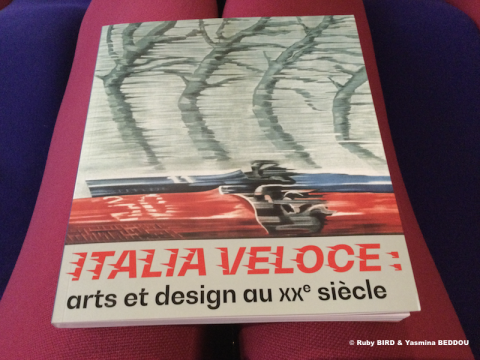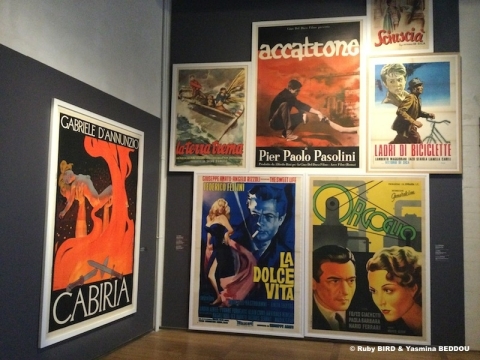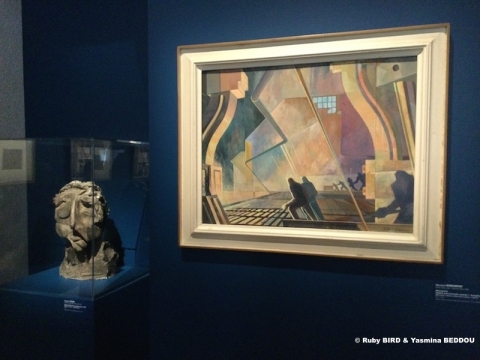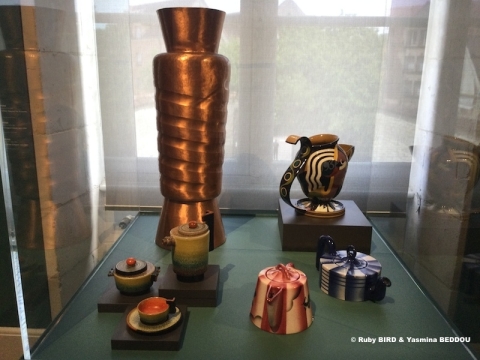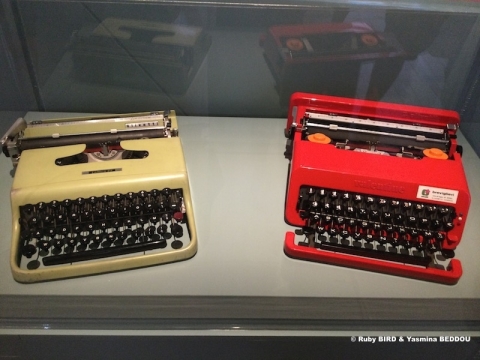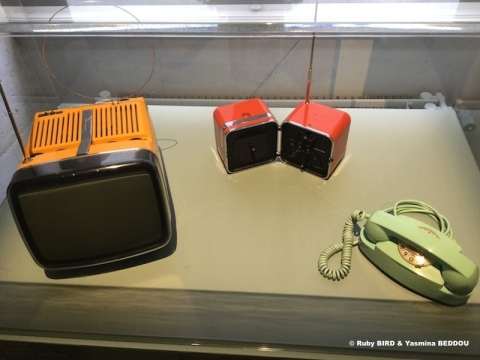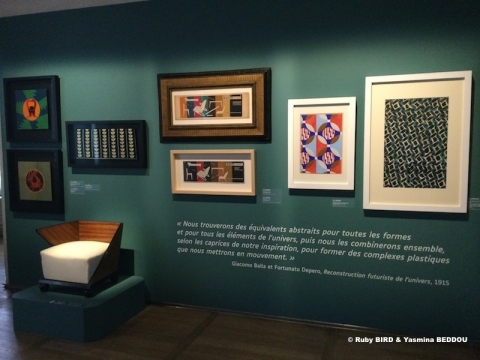Arts
ITALIA VELOCE: ART AND DESIGN IN THE 20th CENTURY AT MODERN ART MUSEUM IN TROYES
June 22 - October 20, 2024

Sonia and Massimo CIRULLI (Source: © Ruby BIRD & Yasmina BEDDOU)
ITALIA VELOCE: Arts and Design in the 20th Century
Selection of Works from the Fondazione Massimo e Sonia Cirulli (June 22 - October 20, 2024)
At "Modern Art Museum - National Collections Pierre and Denise Lévy".
Selection of Works from the Fondazione Massimo e Sonia Cirulli (June 22 - October 20, 2024)
At "Modern Art Museum - National Collections Pierre and Denise Lévy".
- Collecting Modernity
On Both Sides of the Alps, Pierre and Denise Lévy as well as Massimo and Sonia Cirulli are clearly among the Emblematic Collectors of their Time. They have a Certain Number of Common Points that this Exhibition aims to highlight. The most striking of them is, without doubt, their Passion for Art and their Desire to share it.
On Both Sides of the Alps, Pierre and Denise Lévy as well as Massimo and Sonia Cirulli are clearly among the Emblematic Collectors of their Time. They have a Certain Number of Common Points that this Exhibition aims to highlight. The most striking of them is, without doubt, their Passion for Art and their Desire to share it.
In the Space of Four Decades, Pierre Lévy (1907-2002) and his Wife Denise (1911-1993) assembled One of the Most Remarkable French Private Collections of Modern Art. It offers a Unique Panorama of the Major Trends in French Art, from the mid-19th Century to the End of the 1960s, whether Realism, Fauvism or even Cubism and the School of Paris. A Sign of Modernity and Open-Mindedness, it gives a Very Important Place to Non-Western Arts (Africa, Oceania) and the Arts of Fire (Glasswork and Ceramics) in this Representation of Contemporary Artistic Creation.
A Few Decades Later, the Collection of Sonia and Massimo Cirulli reveals the same Passion for Art and an even more Open View of the Diversity of Disciplinary Fields. There we find Paintings and Sculptures by the Great Masters as well as Advertisements, Cinema Posters and Everyday Objects designed by Designers. These Collectors first founded, in the 1980s, in New York, the “Massimo and Sonia Cirulli Archives”. Thirty Years Later, in 2015, they created the Foundation that bears their Name. Like the Collection of the Museum of Modern Art in Troyes, the Chronological Markers of their Collection span more than Half a Century of Creation, from the Birth of Modernity at the Beginning of the 20th Century, until the Boom Italian Economy of the 1960s.
- L’Italia Veloce or the Questioning of Modernity
The Exhibition thus opens with the Research of Futurist Artists who, in the Very Young Kingdom of Italy, exalt the Modern World, in particular Urban Civilization, Machines and Speed. In 1909, Filippo Tommaso Marinetti (1876-1944) published his Manifesto. He synthesizes the Ideas of a Total Renewal of Art, and more Broadly of Society, as well as the Desire for Change carried by an Entire Avant-Garde of Artists. It is not a School, but a Revolutionary Movement whose Goal is to establish a New Sensitivity, a New Approach to the World in General and to Art in particular.
The Exhibition thus opens with the Research of Futurist Artists who, in the Very Young Kingdom of Italy, exalt the Modern World, in particular Urban Civilization, Machines and Speed. In 1909, Filippo Tommaso Marinetti (1876-1944) published his Manifesto. He synthesizes the Ideas of a Total Renewal of Art, and more Broadly of Society, as well as the Desire for Change carried by an Entire Avant-Garde of Artists. It is not a School, but a Revolutionary Movement whose Goal is to establish a New Sensitivity, a New Approach to the World in General and to Art in particular.
The Cirulli Foundation preserves Several Works by Futurist Artists, including those of Umberto Boccioni (1882-1916), Luigi Russolo (1885-1947), Carlo Carrà (1881-1966), Gino Severini (1883-1966) and Giacomo Balla (1871-1958). Boccioni thus breaks down the Movement of the Man At Work, Balla represents, for his Part, the Speed of the Car in Motion. This is One of the Artist's first works on this Theme dear to the Futurists. The Car launched at Full Speed thus embodies the Parameters of Energy and Dynamism to which the Art of the New Century must refer. The Praise of the Moving Machine is found in Gerardo Dottori (1884-1977). Russolo explores the Modern City and the Movement of its Many Lights.
Sonia and Massimo Cirulli also acquired Works by Artists who later adhered to Futurism during the 1930s. Among them were Mario Sironi (1885-1961), Fortunato Depero (1892-1960), Bruno Munari (1907 -1998) or Thayaht (Ernesto Michahelles, 1893-1959). Aeropainting is one of the Major Themes of this Second Group of Artists. After the Automobile, the Plane and the Dizziness of Flight thus become the Symbol of this New Aesthetic. We find it, tinged with Fascist Nationalism, in the Works of Munari and Depero. The Squadra Atlantica flew over Chicago by Alfredo Gauro Ambrosi (1933), a Propaganda Work celebrating the Myth of Flight and refers to the Recent Exploit of the Aviator Italo Balbo who crossed the Atlantic in 1930. Lorenzo Viani and Thayaht transpose the Decomposition of the Movement in Sculpture.
- From the Return to Order to Metaphysical Painting or the Classical Revival
From 1910 and more particularly in the 1920s, there was, quite generally in Europe, a Desire to return to Figuration, to recall the Ancient and the Classic, often described as a “Return To Order". After the Horrors of War, the Need was felt to found Art on Stable Foundations. Metafisica, Archaism, Magical Realism, New Objectivity, Novecento... are Part of this Trend.
From 1910 and more particularly in the 1920s, there was, quite generally in Europe, a Desire to return to Figuration, to recall the Ancient and the Classic, often described as a “Return To Order". After the Horrors of War, the Need was felt to found Art on Stable Foundations. Metafisica, Archaism, Magical Realism, New Objectivity, Novecento... are Part of this Trend.
In Italy, Glergle De Chirice (1888-1978) is the Best-Known Artist of this Movement. This Movement, of Fairly Short Duration, coincides with the Novecento, in which they joined, from the mid-1920s and under the Led by Journalist Margherita Sarfatti, Artists who advocate a Return to Classical Figuration. Opposing Futurism, they celebrate Roman Antiquity, for a Return to the Values ??of the Latin Spirit. From the 1930s, its link with the Propaganda of the Fascist Regime strengthened, causing Novecento to lose its Value as an Independent Artistic Research.
Although the Cirulli Collection does not include any Work by De Chirico, it does show Several Works by Painters linked to these Movements such as Paesaggio Urbano by Mario Sirani (1885-1961). Initially close to the Futurists, the latter joined the Novecento in 1922. The Strange Spectacle of the Ciéserte City is reinforced by a Rigorous Construction, marked by the Vertical Axes and the Strong Contrasts of Shadows and Light. Città Metalsica e Cavallerd by Luigi Zanini (1894-1968), just like The Return of RAM (Ruggero Alfredo Michahelles. 1898-1976) associate City Modernity and Ancient Architecture. La Città Metafisica by Erberto Corbeni (1899-1984) juxtaposes, as in a Collage, a Dreamlike City, a Plan and an Antique Sculpture by Kore.
- Artevita or Modernity at the Heart of Life
Beyond Painting and Sculpture, this Research and this Questioning of Modernity are expressed in the Diffusion of Art in All Areas. Futurism thus advocates a Total Experience with a Massive Development of New Aesthetics in Daily Life: this concerns Music, Architecture, Theater, Cinema, Advertising... In 1915. Balla and Depero signed thus the Manifesto of the Futuristic Reconstruction of the Universe. The Collection of Sonia and Massimo Cirulli reflects this Great Diversity, through the Geometric Formulation of the Furniture of the Painter TATO (Guglielmo Sansoni, 1896-1974), the Dynamic Shapes and Color Contrasts of the Ceramics of Tullio d'Albisola (1899-1971) or even the Futuristic Aesthetic Advertisements of Depero.
Beyond Painting and Sculpture, this Research and this Questioning of Modernity are expressed in the Diffusion of Art in All Areas. Futurism thus advocates a Total Experience with a Massive Development of New Aesthetics in Daily Life: this concerns Music, Architecture, Theater, Cinema, Advertising... In 1915. Balla and Depero signed thus the Manifesto of the Futuristic Reconstruction of the Universe. The Collection of Sonia and Massimo Cirulli reflects this Great Diversity, through the Geometric Formulation of the Furniture of the Painter TATO (Guglielmo Sansoni, 1896-1974), the Dynamic Shapes and Color Contrasts of the Ceramics of Tullio d'Albisola (1899-1971) or even the Futuristic Aesthetic Advertisements of Depero.
From 1911, the Brothers Anton Glullo (1890-1960) and Arturo Bragaglia (1893-1962), Director and Actor respectively, introduced the Principles of Futurism into Photography. In the Field of Architecture, the Drawings of Antonio Sant'Elia (1888-1916) represent a New Urban Utopia adapting to the Lifestyle of Futuristic Man. Gigantic Buildings, Hydroelectric Power Stations or Skyscrapers, stand at the Top of Large Staircases, among Superimposed Roads and Bridges.
If Futurism is found in all Artistic Creation, it is the same for its Classical Revival Counterpart.
Erberto Carboni, Pioneer of Italian Advertising Campaigns, created Logos for RAI (Radiotelevisione Italiana), while RAM applied the Collage Technique and Metaphysical Aesthetics to a Set of Advertising Campaigns testifying to the Birth of Tourism in Italy.
Art is no longer intended for the Museum alone but becomes a Social Practice.
Erberto Carboni, Pioneer of Italian Advertising Campaigns, created Logos for RAI (Radiotelevisione Italiana), while RAM applied the Collage Technique and Metaphysical Aesthetics to a Set of Advertising Campaigns testifying to the Birth of Tourism in Italy.
Art is no longer intended for the Museum alone but becomes a Social Practice.
"Italia Veloce: Arts and Design in the 20th Century" thus bears Witness to these Exchanges between Artists and Industrialists, Designers or Advertisers which are at the Origin of a General Emulation of the Arts. It ends with an Opening on Theater and Cinema, also Actors in this Artistic Proliferation of the 20th Century. This Exhibition takes on a Very Special Meaning within the Troyes Museum of Modern Art where the Collection of Massimo and Sonia Cirulli echoes the Collection of Pierre and Denise Lévy.
Visionary Art Lovers, they are Enlightened Witnesses of their Time. In a Transnational and European Framework, this Presentation seeks to enrich the View of the Works, bring them to Life and introduce the Public, across the Alps, from Bologna to Troyes, to Art under the Gaze of these Inspired Collectors.
Visionary Art Lovers, they are Enlightened Witnesses of their Time. In a Transnational and European Framework, this Presentation seeks to enrich the View of the Works, bring them to Life and introduce the Public, across the Alps, from Bologna to Troyes, to Art under the Gaze of these Inspired Collectors.
- The Massimo and Sonia Cirulli Foundation
The Fondazione Massimo et Sonia Cirulli is a Private Italian Institution founded on the Basis of a Set of Historical Archives dedicated to Italian Culture of the 20th Century, created in New York in 1984 and with an Important Collection.
The Fondazione Massimo et Sonia Cirulli is a Private Italian Institution founded on the Basis of a Set of Historical Archives dedicated to Italian Culture of the 20th Century, created in New York in 1984 and with an Important Collection.
The Cirulli Foundation aims to promote Italian Art and Visual Culture of the 20th Century, from the Birth of Modernity to the Years of the Economic Boom (1900-1970). The Foundation launches Cultural Projects which involve the Organization of Exhibitions, Events and Publications based on the Transversality of the Multiple Disciplinary Areas of Interest of the Collection, on Exchanges with National and International Public and Private Institutions such as Museums, Foundations, Historical Archives, Universities, Companies.
A Transversality facilitated by the Richness of a Collection which involves Different Sectors, from Figurative Art to Architecture and Design, through Graphic Arts to Photography, to tell the History of Italian Culture through Unusual Testimonies. Among the Masters of Italian Art and Architecture, the Collection includes Masterpieces by Giacomo Balla, Osvaldo Licini, Fortunato Depera, Mario Sironi, Lucio Fontana, Gio Ponti, Bruno Munari to name only a Few
The Headquarters of the Fondazione Massimo and Sonia Cirulli is located in San Lazzaro di Savena, a Few Kilometers from Bologna, inside a Building with Strong Architectural Connotations, linked to the History of Italian Design since it was designed in 1960 by Architects and Designers Achille and Pier Giacomo Castiglioni for Dino Gavina.
A Small Masterpiece of Design where, over the Years, many Personalities from the World of Culture have crossed their Chernins: Designers and Artists such as Carlo and Tobia Scarpa, Marcel Breuer, Man Ray and Marcel Duchamp have made a Real Creative Laboratory which today, thanks to the Fondazione Massimo and Sonia Cirulli, is returned to the Public.
- The Museum of Modern Art has had a Facelift since April 16, 2024
The Museum closed its Doors for Major Restoration and Development Work in Spring 2018. Its Renovation aims to provide a Showcase for Redesigned Museography, highlighting and improving the Conservation of the Exceptional Works that make up the Pierre and Denise Lévy Collections. The Exhibition Spaces are renovated and enlarged, the Museum is made Accessible for People with Reduced Mobility. Auditorium, Reception Room, Educational Workshop have been taken over, enlarged, or even created.
The Museum closed its Doors for Major Restoration and Development Work in Spring 2018. Its Renovation aims to provide a Showcase for Redesigned Museography, highlighting and improving the Conservation of the Exceptional Works that make up the Pierre and Denise Lévy Collections. The Exhibition Spaces are renovated and enlarged, the Museum is made Accessible for People with Reduced Mobility. Auditorium, Reception Room, Educational Workshop have been taken over, enlarged, or even created.
- The Sculpture Garden
Designed in 1982 to dialogue with the 16th and 17th Century Architecture of the Facade of the Former Episcopal Palace, the Garden had a Classic “French” Plan, with Lawn Beds framed by Boxwood and Large Gravel Paths. From 1986, it was enriched with Sculptures: Deposits of the National Museum of Modern Art in Paris or Works acquired by the City (Sculptures by Martine Martine, etc.). The Transformation of this Garden is being carried out by Cabinet Métamorphose, which contributed to the Renovation of the Square in Front of the Neighboring Saint-Pierre-et-Saint-Paul Cathedral.
Designed in 1982 to dialogue with the 16th and 17th Century Architecture of the Facade of the Former Episcopal Palace, the Garden had a Classic “French” Plan, with Lawn Beds framed by Boxwood and Large Gravel Paths. From 1986, it was enriched with Sculptures: Deposits of the National Museum of Modern Art in Paris or Works acquired by the City (Sculptures by Martine Martine, etc.). The Transformation of this Garden is being carried out by Cabinet Métamorphose, which contributed to the Renovation of the Square in Front of the Neighboring Saint-Pierre-et-Saint-Paul Cathedral.
Its Aim is to make it a Haven of Greenery and Life, where you can stroll, admire the Sculptures, and rest as well as attend Various and Varied Events. The Landscapers were inspired by the Plan of the Old Episcopal Garden, organized in Rows parallel to the Facade. From this Original Orchard, an Arbor, a Cherry Tree and the Majestic Avenue of Lime Trees have been preserved. The Vegetables and Vines of Yesteryear are replaced by Trees, Shrubs and Perennials because this Garden aims to be a Living Palette in all Seasons, reflecting the Colors of the Works of Art presented inside the Palace.
Source: "ITALIA VELOCE: Arts And Design in the 20th Century"
Selection of works from the Fondazione Massimo e Sonia Cirulli.
June 22 - October 20, 2024
At Modern Art Museum - National collections Pierre and Denise Lévy
Troyes (France)
Ruby BIRD
http://www.portfolio.uspa24.com/
Yasmina BEDDOU
http://www.yasmina-beddou.uspa24.com
Selection of works from the Fondazione Massimo e Sonia Cirulli.
June 22 - October 20, 2024
At Modern Art Museum - National collections Pierre and Denise Lévy
Troyes (France)
Ruby BIRD
http://www.portfolio.uspa24.com/
Yasmina BEDDOU
http://www.yasmina-beddou.uspa24.com
Ruby Bird Yasmina Beddou Art Design 20th Century Works Contemporary Art Paintings Poster Sculptures Modern Art Museum Troyes Fondazione Massimo E Sonia Cirulli Pierre And Denise Lévy Artists Italia Veloce Artevita Collection
Liability for this article lies with the author, who also holds the copyright. Editorial content from USPA may be quoted on other websites as long as the quote comprises no more than 5% of the entire text, is marked as such and the source is named (via hyperlink).

